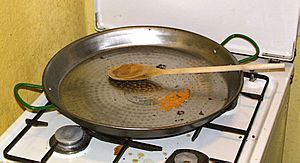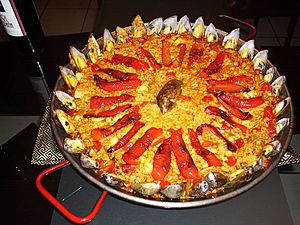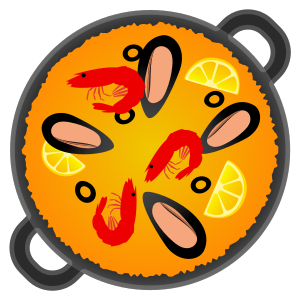Paella facts for kids
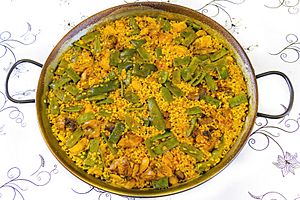
Paella valenciana
|
|
| Course | Main course |
|---|---|
| Place of origin | Spain |
| Region or state | Valencia |
| Serving temperature | warm |
| Main ingredients | Short grain rice, chicken, rabbit, vegetables, green beans, garrofons, saffron |
Paella (pronounced like py-EL-uh or pah-AY-yah) is a famous rice dish that first came from Valencia, a region in Spain. Many people outside Spain think it's the country's national dish. However, most Spaniards see it as a special dish from the Valencian region. For people in Valencia, paella is a very important symbol of their culture. It's one of the most well-known dishes in Spanish cuisine.
The name paella comes from the wide, shallow pan used to cook the dish over an open fire. In Valencia's local language, paella means "frying pan." This dish might have very old roots, but the modern version we know today started in the mid-1800s. It began in the countryside around the Albufera lagoon, near the city of Valencia on Spain's Mediterranean coast.
The most traditional type is Paella valenciana. This is believed to be the original recipe from the Valencia region. It uses round-grain rice, special green beans (called bajoqueta and tavella), rabbit, chicken, and sometimes duck. It also includes garrofó, which is a type of lima or butter bean. The dish is cooked in olive oil and chicken broth. Sometimes, whole rosemary branches are added for flavor. The yellow color usually comes from saffron, but turmeric or calendula can also be used. Artichoke hearts and stems might be added when they are in season. Many paella cooks use a type of rice called bomba rice, but Valencians often prefer senia rice.
Paella de marisco is seafood paella. This version uses seafood instead of meat and doesn't have beans or green vegetables. Paella mixta (mixed paella) combines meat like chicken or rabbit with seafood, vegetables, and sometimes beans, along with the traditional rice. Other popular types of paella are cooked all over the Mediterranean area, the rest of Spain, and around the world.
Contents
The Story of Paella
Where Did Paella Come From?
The Moors were people from North Africa who lived in Muslim Spain a long time ago. They started growing rice in Spain around the 900s. Because of this, people in eastern Spain often made casseroles with rice, fish, and spices for family gatherings and special celebrations. This is how eating rice became a tradition in Spain. By the 1400s, rice was a very common food. Cooks then started mixing rice with vegetables, beans, and dried cod to make meals, especially during Lent. Along Spain's Mediterranean coast, rice was mostly eaten with fish.
A Spanish food expert named Lourdes March says that paella "shows how two important cultures came together." She explains that the Romans gave us the cooking pan, and the Arabs brought us rice, which has been a basic food for centuries.
What's in a Name? The Paella Pan
The word paella is from Valencia and means "frying pan." This is how the dish got its name. People who speak Valencian use the word paella for all kinds of pans, including the special shallow pan used to cook this dish. This pan is usually made of polished or coated steel and has two handles on the sides.
In many parts of Spain and other Spanish-speaking countries, people might call the traditional pan a paellera. They save the word paella just for the rice dish itself. Both paella and paellera are correct names for the pan.
Experts believe the Valencian word paella comes from an old French word, paelle, which also meant "frying pan." That French word came from the Latin word patella, meaning "pan." The word paella is also related to paila, a word used in many Latin American countries. Paila refers to different kinds of metal or clay pans used for cooking and serving.
Some people think the word paella comes from an Arabic word, baqaayya, meaning "leftovers." This idea comes from a custom in the 700s where servants of Moorish kings would take home leftover rice, chicken, and vegetables. However, this idea might not be right because the word paella wasn't recorded until six centuries after the Moors were conquered in Valencia.
The Original Paella Valenciana
Originally, paella made in Valencia was a meal for farmers and farm workers at lunchtime. Workers would use whatever they could find around the rice fields. This often included tomatoes, onions, and snails. Rabbit or duck was often added, and sometimes chicken.
In the 1700s, on special occasions, Valencians used large pots called calderos to cook rice outdoors in their orchards near Albufera lake. Early paellas often included water vole meat, along with eel and butter beans. A writer named Vicente Blasco Ibáñez wrote about the Valencian custom of eating water voles in his 1902 novel, Cañas y Barro.
Life improved in Spain in the late 1800s, and people started having more gatherings and outings in the countryside. This changed the ingredients in paella. People began using rabbit, chicken, duck, and sometimes snails instead. This dish became so popular that in 1840, a local Spanish newspaper first used the word paella to mean the recipe, not just the pan.
The most common list of ingredients from that time included: short-grain white rice, chicken, rabbit, snails (optional), duck (optional), butter beans, great northern beans, runner beans, artichoke (used instead of runner beans in winter), tomatoes, fresh rosemary, sweet paprika, saffron, garlic (optional), salt, olive oil, and water. Poorer Valencians sometimes only used snails for the meat. Many Valencians today say that only these ingredients should be in modern paella valenciana. They believe that fish and shellfish should "absolutely not" be in it. Another rule, according to Valencians, is not to add fresh rosemary to paella valenciana if it's made with snails that eat rosemary.
Seafood and Mixed Paella
Along the Mediterranean coast, Valencian fishermen started making paella with seafood instead of meat and beans. In this recipe, the seafood is often served still in its shell. Later, Spaniards living outside Valencia began mixing seafood with meat from land animals, and that's how mixed paella was created. This mixed paella is sometimes called preparación barroca (baroque preparation) because it has so many different ingredients and looks very fancy.
During the 1900s, paella became popular outside of Spain. As other cultures started making paella, the dish changed to fit local tastes. So, paella recipes went from being quite simple to including many different kinds of seafood, meat, sausage (like chorizo), vegetables, and seasonings. However, seafood paella is the most popular type around the world.
Outside of Valencia, mixed paella is easy to find. Some restaurants in Spain and other countries that serve this mixed version call it Paella valenciana. But Valencians insist that only the original two Valencia recipes are truly authentic. They often see all other versions as not genuine or even strange.
Other Valencian dishes that are made in a similar way include arròs a banda and arròs del senyoret.
How to Cook Paella
In Valencia, paella is traditionally cooked over an open fire. This fire is often made with orange and pine branches and pine cones. This creates a special smoky smell that flavors the paella. Also, people traditionally eat directly from the pan instead of serving it on plates.
Some recipes suggest covering the paella and letting it rest for five to ten minutes after it finishes cooking.
After cooking paella, there might be a crispy layer of roasted rice at the bottom of the pan. This is called socarrat in Valencià. This layer forms naturally if the paella is cooked over a burner or open fire. Many Valencians love to eat this crispy part, as long as it's not burned.
Making Paella Valenciana
This recipe is very traditional in Valencia and is an important part of their culture. The rice in paella valenciana is never browned in oil first, like in some other rice dishes.
- Heat oil in a paella pan.
- Add salt to the meat (chicken and rabbit) and cook it until it's browned.
- Add green vegetables and cook them until they are soft.
- Add garlic (if you like) and grated tomatoes, then add the beans and cook them.
- Add paprika and cook it briefly.
- Pour in water, add saffron (or food coloring), snails (if you like), and rosemary.
- Boil this mixture to make a broth, and let it cook down by half.
- Take out the rosemary once its flavor has mixed in, or if it starts to break apart.
- Add the rice and let it simmer until the rice is cooked.
Some people like to squeeze fresh lemon juice over their paella when they eat it.
Making Seafood Paella (Paella de Marisco)
Recipes for seafood paella can be a bit different, even in Valencia. Here's a common way to make it:
- First, make a seafood broth using shrimp heads, onions, garlic, and bay leaves.
- Heat oil in a paella pan.
- Add mussels. Cook them until they open, then take them out and set aside.
- Cook Norway lobster and whole, deep-water rose shrimp until they are done. Then take them out and set aside.
- Add chopped cuttlefish and cook it.
- Add shrimp tails and cook them.
- Add garlic and cook it.
- Add grated tomato and cook it.
- Add the rice and stir it into the cooked ingredients.
- Add paprika and cook it briefly.
- Pour in the seafood broth and then add saffron (or food coloring).
- Add salt to taste.
- Put the cooked deep-water rose shrimp, mussels, and Norway lobster back into the pan.
- Let it simmer until the rice is cooked.
Making Mixed Paella (Paella Mixta)
There are many, many ways to make mixed paella. Here's a common way, but the seasonings can change a lot based on what you like and where you are. Salt, saffron, and garlic are almost always included.
- Make a broth using seafood, chicken, onions, garlic, bell peppers, and bay leaf.
- Heat oil in a paella pan.
- Cook red bell pepper strips until they are seared, then set them aside.
- Cook crustaceans (like shrimp or lobster) until they are seared, then set them aside.
- Lightly season the meat (like chicken or rabbit) with salt and cook it until it's golden brown.
- Add onions, garlic, and bell peppers. Cook them until they are soft.
- Add grated tomatoes and cook them.
- Add dry seasonings (except salt).
- Add the rice.
- Stir the rice until it's covered with the cooked ingredients.
- Pour in the broth.
- Add salt to taste.
- Add saffron (or food coloring) and mix it well.
- Let it simmer until the rice is almost cooked.
- Put the cooked crustaceans back into the pan.
- Keep simmering until the rice and crustaceans are fully cooked.
- Decorate the top with the seared red bell pepper strips.
Other Paella Dishes
Paella in the Philippines
Arroz a la valenciana (Spanish) or Arroz à valenciana (Portuguese) is a dish found in the Philippines. It's seen as the Philippine version of paella.
The Philippine version uses glutinous rice (sticky rice), but the other ingredients are similar. In the Philippines, arroz a la valenciana often refers to versions made with chicken and longganisa (a type of sausage, like chorizo).
Paella in Pop Culture
Big Paella Competitions
It's a tradition at big events in the Valencia region (like festivals or protests) to cook huge paellas. Sometimes, they even try to set a Guinness World Record. Chefs use giant paelleras for these events.
A restaurant owner from Valencia named Juan Galbis says he made the world's largest paella on October 2, 2001, with the help of a team. This paella fed about 110,000 people! Galbis says this one was even bigger than his earlier record-breaking paella from March 8, 1992, which fed about 100,000 people. His 1992 paella is listed in Guinness World Records.
Paella and Chefs
Some chefs outside Spain put chorizo in their paellas, along with other ingredients that people from Valencia believe don't belong in any type of paella. A funny, but a bit rude, name for these dishes is arroz con cosas, which means "rice with things." Famous examples include Jamie Oliver's paella recipe (which had chorizo) and Gordon Ramsay's. The writer Josep Pla once said:
"The wrong things done in the name of Paella Valenciana are too much – a complete scandal."
—Josep Pla, Catalan Cuisine, Revised Edition: Vivid Flavors From Spain's Mediterranean Coast
However, a Spanish food writer named Ana Vega 'Biscayenne' wrote an article saying that traditional Valencian paella actually did include chorizo in the past. She even joked, "Ah Jamie, we'll have to invite you to the Falles" (a big festival in Valencia).
Paella Emoji
In 2015, an emoji for paella was suggested to Unicode, which creates emojis. The emoji was approved in June 2016 as U+1F958 "SHALLOW PAN OF FOOD"
Similar Dishes
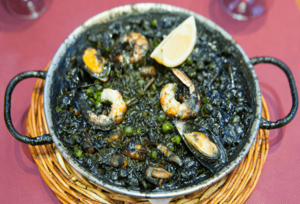
Traditional Valencian cuisine has other recipes similar to paella valenciana and seafood paella. This is because rice is a main ingredient in much of their local food. Some examples are arròs negre, arròs al forn, arròs a banda, and arròs amb fesols i naps.
Fideuà is a Valencian pasta noodle dish that is cooked in a similar way in a paella pan. It can be served with allioli sauce.
Other related dishes include:
- Arroz a la valenciana – A version from Latin America and the Philippines that uses annatto instead of saffron.
- Arroz con gandules – A version from Latin America (Caribbean).
- Arroz con pollo – A Latin American version with chicken.
- Bringhe – A Filipino dish that was influenced by Indian biryani dishes and later by paella during colonial times. It uses glutinous rice, turmeric, and a special ingredient: coconut milk.
- Jambalaya – A dish from Louisiana, USA, influenced by paella and a French dish called jambalaia.
- Locrio – A dish from the Dominican Republic that came from paella.
- Paelya – A Filipino version of paella that specifically uses glutinous rice. It also uses annatto, turmeric, or safflower for color. It's spelled "paella" but pronounced differently.
See also
 In Spanish: Paella para niños
In Spanish: Paella para niños



